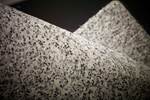Study demonstrates improved abrasion resistance using TFP aramid nonwovens
Study shows aramid veil acts as a sacrificial layer to protect the underlying reinforcement, improves durability and extends composite structure lifespan.

This image shows the composite with the TFP aramid veil after testing. Photo Credit: TFP
Technical Fibre Products (TFP, Burneside, U.K.) reports that a recent study on the use of its aramid nonwoven materials in composite surfacing applications has demonstrated their effectiveness in protecting the underlying structural elements of a composite from the effects of abrasion or wear.
According to TFP, the lightweight aramid veils enable a high-quality surface finish, while simultaneously providing a durable and sacrificial layer in applications such as high-speed composite rollers, automotive friction substrates or sporting goods where the composite experiences a constant friction. Continuous wear, says TFP, can potentially have a detrimental impact on the performance of the composite, as well as significantly reducing the product’s lifespan.
The study carried out examined the effectiveness of using a surfacing veil to increase wear resistance by comparing composite panels fabricated both with and without TFP’s aramid veils. The panels (based on epoxy resin and woven carbon fiber) were tested using a pin-on-disk tribometer to measure friction and wear as a function of time. The data generated demonstrated that the measured coefficient of friction (COF) is significantly lower when an aramid surfacing veil is used, taking at least five times as long to reach the level measured in the control. Essentially, TFP says this indicates that the level of friction experienced by the composite surface is significantly lower and less material is worn away as a result.
This finding has been reinforced by microscope imaging of the samples, which only show damage — and no breakage — to the surface fibers, and no damage to or exposure of the woven reinforcement in the composite panels containing aramid surface veil. TFP notes that this can be compared to the evidence of significant fiber breakage and damage to the underlying carbon fiber weave in the control panel.
Ultimately, the findings are said to demonstrate the importance of the aramid veil in acting as a sacrificial layer to protect the underlying reinforcement, increasing durability of the composite structure and extending its lifespan. More information on the study (including data and images) can be found here.
In addition to abrasion resistance, TFP’s nonwovens are used to confer a wide range of composite functionalities, including conductivity or EMI shielding (via metal-coated veils), corrosion resistance (glass or carbon fiber) and fire protection (with Tecnofire). The company’s nonwovens are also widely used as surfacing veils, and ensure uniform resin uptake, elimination of dry spots, minimized print-through and fiber breakout and deliver a high-quality surface finish.
Related Content
-
Testing to support composite bolted joint analysis
An overview of ASTM Standard Guide D8509, and its coupon-level mechanical testing of design properties for analyzing composite bolted joints.
-
Automated robotic NDT enhances capabilities for composites
Kineco Kaman Composites India uses a bespoke Fill Accubot ultrasonic testing system to boost inspection efficiency and productivity.
-
Active core molding: A new way to make composite parts
Koridion expandable material is combined with induction-heated molds to make high-quality, complex-shaped parts in minutes with 40% less material and 90% less energy, unlocking new possibilities in design and production.
















